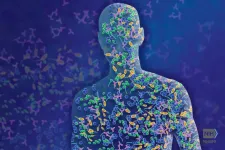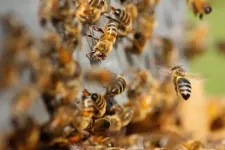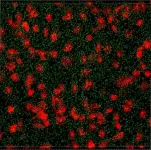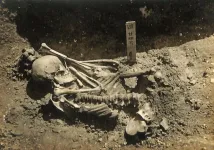(Press-News.org) A new study published in Nature Communications finds that piles of sand grains, even when undisturbed, are in constant motion. Using highly-sensitive optical interference data, researchers from the University of Pennsylvania and Vanderbilt University present results that challenge existing theories in both geology and physics about how soils and other types of disordered materials behave.
Most people only become aware of soil movement on hillsides when soil suddenly loses its rigidity, a phenomenon known as yield. "Say that you have soil on a hillside. Then, if there's an earthquake or it rains, this material that's apparently solid becomes a liquid," says principal investigator Douglas Jerolmack of Penn. "The prevailing framework treats this failure as if it's a crack breaking. The reason that's problematic is because you're modeling the material by a solid mechanical criterion, but you're modeling it at the point at which it becomes a liquid, so there's an inherent contradiction."
Such a model implies that, below yield the soil is a solid and therefore should not flow, but soil slowly and persistently "flows" below its yield point in a process known as creep. The prevailing geological explanation for soil creep is that it is caused by physical or biological disturbances, such as freeze-thaw cycles, fallen trees, or burrowing animals, that act to move soil.
In this study, lead author and Penn Ph.D. candidate Nakul S. Deshpande was interested in observing individual sand particles at rest which, based on existing theories, should be entirely immobile. "Researchers have built models by presuming certain behaviors of the soil grains in creep, but no one had actually just directly observed what the grains do," says Deshpande.
To do this, Deshpande set up a series of seemingly simple experiments, creating sand piles in small plexiglass boxes on top of a vibration isolation worktable. He then used a laser light scattering technique called diffusing-wave spectroscopy, which is sensitive to very small grain movements. "The experiments are technically challenging," Deshpande says about this work. "Pushing the technique to this resolution is not yet common in physics, and the approach doesn't have a precedent in geosciences or geomorphology."
Deshpande and Jerolmack also worked with long-time collaborator Paulo Arratia, who runs the Penn Complex Fluids Lab, to connect their data with frameworks from physics, materials science, and engineering to find analogous systems and theories that could help explain their results. Vanderbilt's David Furbish, who uses statistical physics to study how particle motions influence large-scale landscape changes, provided explanation for why previous models were physically inadequate and inconsistent with what the researchers had found.
The first experiments were seemingly easy: Pour a pile of sand into the box, let it sit, and watch with the laser. But the researchers discovered that, while intuition and prevailing theories say that the undisturbed piles of sand should be static, sand grain piles are in fact a mass of constant movement and behave like glass.
"In every way that we can measure the sand, it is relaxing like a cooling glass," says Deshpande. "If you were to take a bottle and melt it, then freeze it again, that behavior of those molecules in that cooling glass are, in every way that we're capable of measuring, just like the sand."
In physics, glass and soil particles are classic examples of a "disordered" system, one whose constituent particles are arranged randomly instead of in crystalline, well-defined structures. While disordered materials, a major focus area of Penn's Materials Research Science & Engineering Center, share some common behaviors in terms of how they deform when stressed, there is an important difference between glass and a pile of sand. The molecules that make up glass are always moving randomly at a rate that depends on temperature, but sand grains are too large to do that. Because of that, physicists expect that a pile of sand would be "jammed" and unmoving, but these latest findings present a new way of thinking about soil for researchers in both physics and geology.
Another surprising result was that the rate of creeping soil could be controlled based on the types of disturbances used. While the undisturbed sandpile continued to creep for as long as the researchers observed, the rate of particle motion slowed through time in a process called aging. When sand particles were heated, this aging was reversed such that creep rates increased back to their initial value. Tapping the pile, in contrast, accelerated aging.
"We tend to think of things that drive soil toward yield, like shaking from an earthquake that triggers a landslide, but other disturbances in nature potentially drive soil further away from yield, or make it harder for a landslide to happen," says Jerolmack. "Nakul's ability to tune it further or closer to yield was like a bomb that went off for us, and this is an all-new area."
In the near term, the researchers are working on follow-up experiments to recreate the impacts of localized disturbances using magnetic probes to understand how disturbances could lead a system further away from or closer to yield. They are also looking at data from field observations, from natural soil creep to catastrophic landslide events, to see if they can connect their lab experiments to what observers see in the field, potentially enabling new ways to detect catastrophic landscape failures before they happen.
The researchers hope that their work can be a starting point for refining existing theories that rely on a paradigm that, like a hillside whose soil particles have shifted over time, no longer holds weight. "When you observe something really counterintuitive and new, it's going to now take a long time before that turns into a model to use," says Jerolmack. "I hope on the geoscience side that people with sophisticated tools and techniques and experience will pick up where we've ended and say, 'I have a new idea for seeking this signature in the field that you wouldn't have thought of'--that natural handoff of scales and abilities and interests."
INFORMATION:
This research was supported by Army Research Office Grant W911NF-20-1-0113 and National Science Foundation Materials Research Science and Engineering Center Grant DMR-1720530.
WHAT:
National Institutes of Health scientists and their collaborators have identified an internal communication network in mammals that may regulate tissue repair and inflammation, providing new insights on how diseases such as obesity and inflammatory skin disorders develop. The new research is published in Cell.
The billions of organisms living on body surfaces such as the skin of mammals--collectively called microbiota--communicate with each other and the host immune system in a sophisticated network. According to the study, viruses integrated in the host genome, remnants of previous infections called endogenous retroviruses, can control how the host immune system and the microbiota ...
Beekeepers across the United States lost 45.5% of their managed honey bee colonies from April 2020 to April 2021, according to preliminary results of the 15th annual nationwide survey conducted by the nonprofit Bee Informed Partnership (BIP). These losses mark the second highest loss rate the survey has recorded since it began in 2006 (6.1 percentage points higher than the average annual loss rate of 39.4%). The survey results highlight the continuing high rates of honey bee colony turnover. The high loss rate was driven by both elevated summer and winter losses this year, with no clear progression toward improvement ...
Those with power, such as the wealthy are more likely to blame others for having shortcomings and they are also less troubled by reports of inequality, according to recent research from the University of California San Diego's Rady School of Management.
The study published in END ...
BROOKLYN, New York, Wednesday, June 23, 2021 -- Owing to their tunable properties, hydrogels comprising stimuli-sensitive polymers are among the most appealing molecular scaffolds because their versatility allows for applications in tissue engineering, drug delivery and other biomedical fields.
Peptides and proteins are increasingly popular as building blocks because they can be stimulated to self-assemble into nanostructures such as nanoparticles or nanofibers, which enables gelation -- the formation of supramolecular hydrogels that can trap water and small molecules. Engineers, to generate such smart biomaterials, are developing systems that can respond to a multitude of stimuli including heat. Although thermosensitive hydrogels are among widely ...
Irvine, CA - June 23, 2021 - A new University of California, Irvine-led study finds that the persistence of a marker of chronic cellular stress, previously associated with neurodegenerative diseases such as amyotrophic lateral sclerosis (ALS) and frontotemporal dementia (FTD), also takes place in the brains of Huntington's disease (HD) patients.
Chronic cellular stress results in the abnormal accumulation of stress granules (SGs), which are clumps of protein and RNAs that gather in the cell. Prior to this study, published in the Journal of Clinical ...
Boston, MA--Early in the COVID-19 pandemic, many African leaders implemented prevention measures such as lockdowns, travel bans, border closures, and school closures. While these efforts may have helped slow the spread of the virus on the continent and continue to be important for its containment, they inadvertently disrupted livelihoods and food systems and curtailed access to critical nutrition, health, and education services. A new series of studies by researchers from Harvard T.H. Chan School of Public Health and colleagues from the Africa Research, Implementation Science and Education (ARISE) Network finds that these disruptions may have serious ...
AMES, Iowa -- A new study of small Iowa towns found that vulnerable populations within those communities face significantly more public health risks than statewide averages.
The study, published this week in PLOS ONE, a peer-reviewed open access journal, was led by Benjamin Shirtcliff, associate professor of landscape architecture at Iowa State University.
He focused on three Iowa towns - Marshalltown, Ottumwa and Perry - as a proxy for studying shifting populations in rural small towns, in particular how vulnerable populations in these towns ...
Our planet is warming due to anthropogenic greenhouse gas emissions; but the warming differs from region to region, and it can also vary seasonally. Over the last four decades scientists have observed a persistent austral summer cooling on the eastern side of Antarctica. This puzzling feature has received world-wide attention, because it is not far away from one of the well-known global warming hotspots - the Antarctic Peninsula.
A new study published in the journal Science Advances by a team of scientists from the IBS Center for Climate Physics at Pusan National University in South Korea, Nanjing University of Information Science and Technology, NOAA Geophysical Fluid Dynamics Laboratory, University Corporation for Atmospheric Research, Ewha Womans University, and National Taiwan ...
A new study from archaeologists at University of Sydney and Simon Fraser University in Vancouver, has provided important new evidence to answer the question "Who exactly were the Anglo-Saxons?"
New findings based on studying skeletal remains clearly indicates the Anglo-Saxons were a melting pot of people from both migrant and local cultural groups and not one homogenous group from Western Europe.
Professor Keith Dobney at the University of Sydney said the team's results indicate that "the Anglo-Saxon kingdoms of early Medieval Britain were strikingly similar to contemporary Britain - full of people of different ancestries sharing a common language and culture".
The Anglo-Saxon (or early medieval) period in England runs from the 5th-11th centuries AD. Early Anglo-Saxon dates from ...
Newspapers regularly carry stories of terrifying shark attacks, but in a paper published today, Oxford-led researchers reveal their discovery of a 3,000-year-old victim - attacked by a shark in the Seto Inland Sea of the Japanese archipelago.
The research in Journal of Archaeological Science: Reports, shows that this body is the earliest direct evidence for a shark attack on a human and an international research team has carefully recreated what happened - using a combination of archaeological science and forensic techniques.
The grim discovery of the victim was made by Oxford researchers, J. Alyssa White and Professor Rick Schulting, while investigating evidence for violent trauma on the skeletal remains of prehistoric hunter-gatherers at ...






